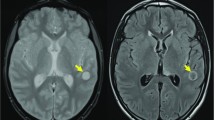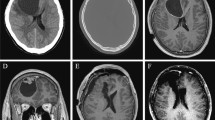Abstract
We describe a 19-year-old woman with onset of epileptic seizure, and a small mural nodule and multicystic lesions with severe brain edema located in the right frontal lobe. At surgery, the tumor and a clear margin was removed, and symptoms improved postoperatively. Extended local radiotherapy (60 Gy) was performed. Histopathological examination revealed oligodendroglioma-like tumor cells with a perinuclear halo. The tumor cells extended processes toward CD34-positive proliferating vessels, which resemble a basement membrane. These proliferating vessels formed a tumor membrane so that there was a clear margin between the tumor and brain tissue. Tumor cells were positive for epithelial membrane antigen in a dot-like pattern. MIB-1 staining index was 50.6%. Electron microscopy showed cilia and zipper-like junctions, and anaplastic clear-cell ependymoma grade III was diagnosed. A characteristic of the case was formation of a tumor membrane by proliferating tumor blood vessels. Fluorescence in situ hybridization showed 1p/19q deletions, and the concentration of erythropoietin in the cyst fluid was abnormally high, at 1,859.4 mIU/ml. Erythropoietin and erythropoietin receptors were verified with immunohistochemical staining.









Similar content being viewed by others
References
The Community of Brain Tumor Registry of Japan (2009) Report of Brain Tumor Registry of Japan (1984–2000), 12th end. Neurol Med Chir (Tokyo) 49 suppl:1–22
McLendon RE, Wiestler OD, Kros LM, Korshunov A, Ng HK (2007) Ependymoma. In: Louis DN, Ohgaki H, Wiestler OD, Cavenee WK (eds) World health organization classification of tumours of the central nervous system, 4th edn. IARC, Lyon, pp 74–78
Preusser M, Laggner U, Haberler C, Heinzl H, Budka H, Hainfellner JA (2006) Comparative analysis of NeuN immunoreactivity in primary brain tumours: conclusions for rational use in diagnostic histopathology. Histopathology 48:438–444
Fouladi M, Helton K, Dalton J et al (2003) Clear cell ependymoma: a clinicopathologic and radiographic analysis of 10 patients. Cancer 98:2232–2244
Min KW, Scheithauer BW (1997) Clear cell ependymoma: a mimic of oligodendroglioma: clinicopathologic and ultrastructural considerations. Am J Surg Pathol 21:820–826
Kawano N, Yada K, Aihara M, Yagishita S (1983) Oligodendroglioma-like cells (clear cells) in ependymoma. Acta Neuropathol 62:141–144
Kawano N, Yada K, Yagishita S (1989) Clear cell ependymoma: a histological variant with diagnostic implications. Virchows Arch A Pathol Anat Histopathol 415:467–472
Kurimoto M, Nagai S, Hamada H et al (2009) Malignant transformation of supratentorial clear cell ependymoma. Neuropathology 29:299–302
Kubota T, Hirano A, Tanaka R, Takahashi H (2006) Fine structural study of a cerebral tumor characterized by a honeycomb appearance after a 20-year post-mortem interval. Neuropathology 26:158–160
Asano K, Takeda T, Nakano T, Ohkuma H (2010) Correlation of MIB-1 staining index and (201)Tl-SPECT retention index in preoperative evaluation of malignancy of brain tumors. Brain Tumor Pathol 27:1–6
Cosar M, Hatiboglu MA, Iplikcioglu AC, Ozcan D (2006) Parasagittal leptomeningeal hemangioblastoma: case report. Neurol Med Chir (Tokyo) 46:294–297
Karabagli H, Karabagli P, Alpman A, Durmaz B (2007) Congenital supratentorial cystic hemangioblastoma. Case report and review of the literature. J Neurosurg 107(6 Suppl):515–518
Takeuchi H, Hashimoto N, Kitai R, Kubota T (2008) A report of supratentorial leptomeningeal hemangioblastoma and a literature review. Neuropathology 28:98–102
Fallon KB, Palmer CA, Roth KA et al (2004) Prognostic value of 1p, 19q, 9p, 10q, and EGFR-FISH analyses in recurrent oligodendrogliomas. J Neuropathol Exp Neurol 63:314–322
Kawano N, Utsuki S (2009) Ependymoma. In: Kawamoto K, Yoshida J, Nakazato Y (eds) Color atlas of brain tumor pathology, 3rd edn. Igakusyoin, Tokyo, pp 52–55
Blümcke I, Müller S, Buslei R, Riederer BM, Wiestler OD (2004) Microtubule-associated protein-2 immunoreactivity: a useful tool in the differential diagnosis of low-grade neuroepithelial tumors. Acta Neuropathol 108:89–96
Rodriguez FJ, Scheithauer BW, Robbins PD et al (2007) Ependymomas with neuronal differentiation: a morphologic and immunohistochemical spectrum. Acta Neuropathol 113:313–324
Gessi Mr, Marani C, Geddes J, Arcella A, Cenacchi G, Giangaspero F (2005) Ependymoma with neuropil-like islands: a case report with diagnostic and histogenetic implications. Acta Neuropathol 109:231–234
Hasselblatt M, Paulus W (2003) Sensitivity and specificity of epithelial membrane antigen staining patterns in ependymomas. Acta Neuropathol 106:385–388
Kawano N, Yasui Y, Utsuki S, Oka H, Fujii K, Yamashina S (2004) Light microscopic demonstration of the microlumen of ependymoma: a study of the usefulness of antigen retrieval for epithelial membrane antigen (EMA) immunostaining. Brain Tumor Pathol 21:17–21
Mahfouz S, Aziz AA, Gabal SM, el-Sheikh S (2008) Immunohistochemical study of CD99 and EMA expression in ependymomas. Medscape J Med 10:41
Mannoji H, Becker LE (1988) Ependymal and choroid plexus tumors. Cytokeratin and GFAP expression. Cancer 61:1377–1385
Sharma MC, Ghara N, Jain D, Sarkar C, Singh M, Mehta VS (2009) A study of proliferative markers and tumor suppressor gene proteins in different grades of ependymomas. Neuropathology 29:148–155
Armstrong TS, Vera-Bolanos E, Bekele BN, Aldape K, Gilbert MR (2010) Adult ependymal tumors: prognosis and the M. D. Anderson Cancer Center experience. Neuro Oncol 12:862–870
Li Y, Juul SE, Morris-Wiman JA, Calhoun DA, Christensen RD (1996) Erythropoietin receptors are expressed in the central nervous system of mid-trimester human fetuses. Pediatr Res 40:376–380
Grasso G, Sfacteria A, Passalacqua M et al (2005) Erythropoietin and erythropoietin receptor expression after experimental spinal cord injury encourages therapy by exogenous erythropoietin. Neurosurgery 56:821–827
Sakanaka M, Wen TC, Matsuda S et al (1998) In vivo evidence that erythropoietin protects neurons from ischemic damage. Proc Natl Acad Sci USA 95:4635–4640
Mohyeldin A, Dalgard CL, Lu H et al (2007) Survival and invasiveness of astrocytomas promoted by erythropoietin. J Neurosurg 106:338–350
Yin D, Kawabata H, Tcherniamtchouk O, Huynh T, Black KL, Koeffler HP (2007) Glioblastoma multiforme cells: expression of erythropoietin receptor and response to erythropoietin. Int J Oncol 31:1193–1198
Batra S, Perelman N, Luck LR, Shimada H, Malik P (2003) Pediatric tumor cells express erythropoietin and a functional erythropoietin receptor that promotes angiogenesis and tumor cell survival. Lab Invest 83:1477–1487
Hassouna I, Sperling S, Kim E et al (2008) Erythropoietin augments survival of glioma cells after radiation and temozolomide. Int J Radiat Oncol Biol Phys 72:927–934
Korshunov A, Neben K, Wrobel G et al (2003) Gene expression patterns in ependymomas correlate with tumor location, grade, and patient age. Am J Pathol 163:1721–1727
Rousseau E, Palm T, Scaravilli F et al (2007) Trisomy 19 ependymoma, a newly recognized genetico-histological association, including clear cell ependymoma. Mol Cancer 6:47
Rickert CH, Korshunov A, Paulus W (2006) Chromosomal imbalances in clear cell ependymomas. Mod Pathol 19:958–962
Chamberlain MC, Johnston SK (2009) Temozolomide for recurrent intracranial supratentorial platinum-refractory ependymoma. Cancer 115:4775–4782
Green RM, Cloughesy TF, Stupp R et al (2009) Bevacizumab for recurrent ependymoma. Neurology 73:1677–1680
Acknowledgments
The authors express their deep gratitude to Professor Osami Kubo, Department of Neurosurgery, Tokyo Women’s University, and Dr. Takashi Komori, Department of Clinical Neuropathology, Tokyo Metropolitan Institute for Neuroscience, for their valuable discussion and advice leading to completion of this manuscript.
Author information
Authors and Affiliations
Corresponding author
Rights and permissions
About this article
Cite this article
Asano, K., Kudo, K., Mori, F. et al. A case of anaplastic clear-cell ependymoma presenting with high erythropoietin concentration and 1p/19q deletions. Brain Tumor Pathol 28, 317–327 (2011). https://doi.org/10.1007/s10014-011-0043-3
Received:
Accepted:
Published:
Issue Date:
DOI: https://doi.org/10.1007/s10014-011-0043-3




